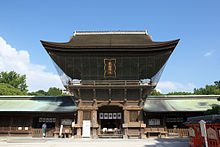Hakozaki Shrine
| Hakozaki Shrine (筥崎宮, Hakozaki-gū) | |
|---|---|
 Hakozaki Shrine's rōmon | |
| Religion | |
| Affiliation | Shinto |
| Deity | Emperor Ōjin Empress Jingū Tamayori-hime |
| Location | |
| Geographic coordinates | 33°36′52″N 130°25′24″E / 33.61444°N 130.42333°E |
Hakozaki Shrine (筥崎宮, Hakozaki-gū) is a Shintō shrine in Fukuoka .[1]
History
[edit]
Hakozaki Shrine was founded in 923, with the transfer of the spirit[citation needed] of the kami Hachiman from Daibu Hachiman Shrine in what is Honami Commandry, Chikuzen Province in Kyūshū.

During the first Mongol invasion on November 19, 1274 (Bun'ei 11, 20th day of the 10th month), the Japanese defenders were pushed back from the several landing sites.[3] In the ensuing skirmishes, the shrine was burned to the ground.[4] When the shrine was reconstructed, a calligraphy Tekikoku kōfuku (敵国降伏; surrender of the enemy nation) was put on the tower gate. The calligraphy was written by Emperor Daigo, dedicated by Emperor Daijo Kameyama as a supplication to Hachiman to defeat invaders.
The shrine is highly ranked among the many shrines in Japan. It was listed in Engishiki-jinmyōchō (延喜式神名帳) edited in 927. In 11th or 12th century, the shrine was ranked as Ichinomiya (一宮; first shrine) of Chikuzen Province.
From 1871 to 1946, Hakozaki was officially designated a Kanpei-taisha (官幣大社), in the first rank of government supported shrines. Other similar Hachiman shrines were Iwashimizu Hachimangū of Yawata in Kyoto Prefecture and Usa Shrine of Usa in Ōita Prefecture.[5]
Shinto belief
[edit]Hakozaki Shrine is dedicated to the veneration of the kami Hachiman.[6] This shrine especially venerates the memory of Emperor Ōjin, Empress Jingū and Tamayori-bime.[7]
Treasures
[edit]A number of structures in the shrine complex have been designated as important cultural assets of Japan, including the main hall, the worship hall, tower gate and the main Torii, Ichino-torii.[7] This torii gate was demolished in 2018, as it became too expensive to repair after pieces started to fall off. It has not been replaced.[8]
Festivals
[edit]The annual Tamaseseri Festival (January 3) and the Hojoya Festival (September 12–18) attract many visitors to the shrine.[7]
Shinan Ship
[edit]Hakozaki-gu was one of the intended destinations of the cargo that the so called Shinan ship was to deliver from Ningbo to Hakata which route was also one of the final sections of the historic Maritime Silk Route. The ship sailed in the 14th century before it sank close to Korean shores due to bad weather conditions. This became apparent after the wreckage was found almost seven hundred years later. On some of the wooden labels or wooden tags(木間) that were used customarily to identify the cargo, the Chinese calligraphy characters of Hakozaki Shrine(筥崎宮) could be clearly read. The main destination of the ship’s cargo was Tofuku-ji Temple in Kyoto as a fire caused serious damage and materials for reconstruction as well as replacements for artifacts were needed. Joten-ji Temple in Hakata was also to receive some of the ship’s valuable cargo.[9][10]
See also
[edit]Notes
[edit]- ^ Ponsonby-Fane, Richard. (1962). Studies in Shinto and Shrines, p. 339.
- ^ "Mongol Invasions of Japan". Archived from the original on 2003-04-06. Retrieved 2017-08-29.
- ^ Davis, Paul K. (2001). 100 decisive battles: from ancient times to the present, p. 147.
- ^ Turnbull, Stephen R. (2003). Genghis Khan & the Mongol Conquests 1190–1400, p. 66.[permanent dead link]
- ^ Ponsonby-Fane, Richard Arthur Brabazon. (1959). The Imperial House of Japan, pp. 124-126.
- ^ Ponsonby-Fane, Shrines, p. 195.
- ^ a b c Fukuoka/Hakata Tourist Information website: Hakozaki Shrine.
- ^ "Torii Gate at Hakozakigu Shrine to be Demolished".
- ^ "The Return of the Celadons". Gwangju News. 2019-07-05. Retrieved 2024-03-09.
- ^ "新案船 (Shinan Ship) Folder". titled video, please check at 2 min 22 sec. for “Hakozaki-gu” characters(from youtube channel of user “chang gyong”). 2021-04-24. Retrieved 2024-03-09.
References
[edit]- Davis, Paul K. (1999). 100 Decisive Battles: From Ancient Times to the Present. Oxford: Oxford University Press. ISBN 978-0-19-514366-9; OCLC 0195143663
- Ponsonby-Fane, Richard Arthur Brabazon. (1962). Studies in Shinto and Shrines. Kyoto: Ponsonby Memorial Society. OCLC 399449
- Turnbull, Stephen R. (2003). Genghis Khan & the Mongol Conquests, 1190-1400. London: Taylor & Francis. ISBN 978-0-415-96862-1
External links
[edit]- (in Japanese) Hakozaki Shrine website
- (in Japanese) Fukuoka/Hakata Tourist Information website, Hakozaki Shrine, images + video


